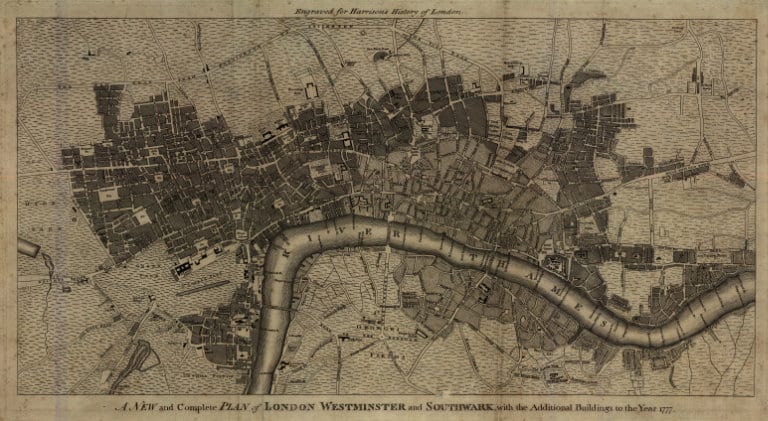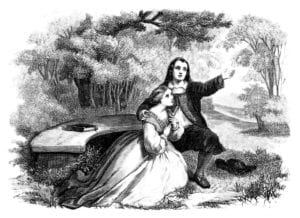What did London mean to Shakespeare? Curiously, it seems he never thought of London as his home. He probably arrived in the capital in the late 1580s, but it was 25 years before he bought a house there. It wasn’t that he couldn’t afford it: he became rich quite quickly, but he preferred to invest in Stratford, where his wife and two daughters lived, while he maintained a rented room in London. When he appeared in a court case in the capital in 1612, he described himself as William Shakespeare of Stratford.
Allowing for this personal sense of detachment from the city, what kind of place did he know as London? First, its centre of gravity was further east than the present city, revolving around landmarks like the Tower of London, St Paul’s Cathedral, London Bridge, Lambeth Palace and to the west, the (separate) city of Westminster. And south of the river, the Globe Theatre, in a district of the expanding city reserved for entertainments, savoury and otherwise: bear-baiting, for example. There was a single bridge connecting Shakespeare’s lodgings north of the river with work to the south – unless he chose to risk his life in a wherry or rowing boat, which would take him over the Thames for a penny.
Shakespeare’s London was of course much smaller than the present version. At the turn of the seventeenth century, it had a population of around 200,000, making it the third largest city in Europe, after Naples (280,000) and Paris (220,000). Towns of a similar size today include Gateshead (202,000) and Colchester (194,000). In Shakespeare’s England, London was by far the largest town or city, ahead of Norwich in second place (15,000), York and Bristol (both 12,000) and Newcastle (10,000). No other city in England had double figures, which means no other city had five per cent of the population of London. Stratford, incidentally, had a population of 2,500.
Many of London’s inhabitants would not have been native Londoners, or indeed native English. London’s been a safe haven for refugees from political or religious chaos for the best part of half a millennium, and Shakespeare’s London was no different. Prominent among the refugees were the Huguenots, Protestants fleeing Catholic France, and indeed Shakespeare lodged with a Huguenot family in Silver Street for several years. With refugees come those minded to resent them, though Queen Elizabeth’s decision to expel Jewish people from England receives something of a rejoinder in the character of Shylock (“Doth not a Jew bleed?” etc.), and plans to exclude people of African descent from the country may have helped to shape the creation of Othello. It is striking that the speech believed to have been written by Shakespeare in “Sir Thomas More” is a plea for tolerance of immigrants.
These numbers of London’s inhabitants were always in a state of flux, not least because of the plague. This curse had a colossal influence on Elizabethan society, culling huge proportions of the population. In the year before Shakespeare was born, of the 20,000 deaths recorded in London, 17,500 were down to the plague: nearly 90 per cent. In the last year of Queen Elizabeth’s reign, there were 40,000 deaths in London, over 32,000 because of the plague: around one in eight of the city’s population. For comparison, Covid 19 has culled (at the time of writing) around 0.2 per cent of the British population. How did London cope? One solution was to close the theatres, regarded as highly culpable in the spread of the disease. As a result, Shakespeare spent the plague years of 1593 and 1594 composing two lengthy poems (“Venus and Adonis” and “The Rape of Lucrece”) which sold in huge numbers and made him very rich.
Shakespeare’s wealth would have afforded him privileges not available to fellow-citizens of fewer means. Regulations governing clothing and social class – the so-called “Sumptuary Laws” – permitted (for example) the daughters of knights to wear silk where lower class women would be expected to sport nothing more exotic than linen or wool. Similarly, gentlemen attending the Queen were permitted to wear gold and silver trimmings on their clothing, a privilege denied to lower class men. It is telling that when Macbeth is told that he is to become Thane of Cawdor, he objects that “The Thane of Cawdor lives,” and asks “why do you dress me / In borrow’d robes?”
Later when Macbeth’s fate seems inescapable, he complains that “They have tied me to a stake” and concludes that “I cannot fly, / But bear-like I must fight the course”. Once again this simile would have resonated with his audience, since the Globe Theatre was located close to arenas dedicated to bear-baiting and cock-fighting. Such entertainments would have required a strong stomach. In the case of the former, the bear, sometimes blindfolded and unable to defend itself properly, was attacked by packs of dogs. Horses were sometimes used for the same purpose.
Strong stomachs would also have been required to witness the systems of crime and punishment in place in Shakespeare’s London. Legal systems in a modern state are relatively private affairs but there was nothing private about the system of punishment in place in Tudor London. On the contrary, punishment was seen as a way of keeping the peace by making examples of those found to have breached it. The stocks were a familiar resort for minor offences. After that, things get serious: noses and tongues can be split, ears can be gored with hot irons, and foreheads can be branded. Amputations are acceptable: John Stubbs published a pamphlet arguing that the Queen should not marry the brother of the King of France, and had his right hand cut off as punishment for his impudence. He spent the next eighteen months in prison.
Executions were routine and presented as public spectacle. True, when the Earl of Essex was beheaded in 1601, it was conducted in the Tower of London, away from prying eyes. Other executions, however, were intended as examples to the public: the ritual of hanging, drawing and quartering is well known – suffice to say that the head was hacked off before the body was divided between the four limbs. A worse fate awaited those sentenced to be burnt, given that the human body is ninety per cent water and doesn’t burn until it has dried out.
In retrospect the crimes that catch the eye from this period are the headline-grabbing acts of treason (the Earl of Essex) or insurrection (the Gunpowder Plot): Essex was permitted a private execution but the fate of the plotters was more public: Guy Fawkes and his associates were hanged, then cut down while still conscious, castrated and disembowelled, then beheaded and hacked into quarters. Two of their companions, already dead, were dug up and the heads were removed for display. The removal of heads is a familiar punishment in Shakespeare’s plays: Macbeth’s head is hacked off (“Re-enter MACDUFF, with MACBETH’S head” runs the stage direction), and in “Measure for Measure”, the stand-in city governor Angelo orders Claudio to be beheaded and asks for the head to be sent to him as proof that the sentence was carried out.
Other crimes, serious or otherwise, ranged from Recusancy – the failure to attend Church of England services, for which a small fine would be levied – to theft, for which anything up to the death penalty might be imposed. Alternative sanctions included whipping, branding and (as we saw) amputation. The death penalty involved an imaginative range of options, including pressing (being crushed by stones) and being boiled alive. Punishments attracted crowds, as they were meant to, to get the message across.
Happier times might be spent at the tavern, where food and drink, shelter and even exotic company might be found, as evidenced in “Henry IV Part Two”. Here Falstaff can be seen enjoying a good meal in the company of two young ladies, talking down the heir to the throne – who, by way of a practical joke, has disguised himself as a waiter and is listening in. Some coaching inns also doubled as primitive theatres, before a surge in the construction of purpose-built arenas (including the Globe) towards the end of the century made a number of impresarios very rich – Shakespeare among them. Most of this wealth went home to Stratford but enough was left to finance the purchase of lodgings in the Blackfriars gatehouse just north of the river. But he seems not have lived there, preferring instead to rent it out soon after his purchase. As mentioned earlier, it seems that London never quite felt like home.




